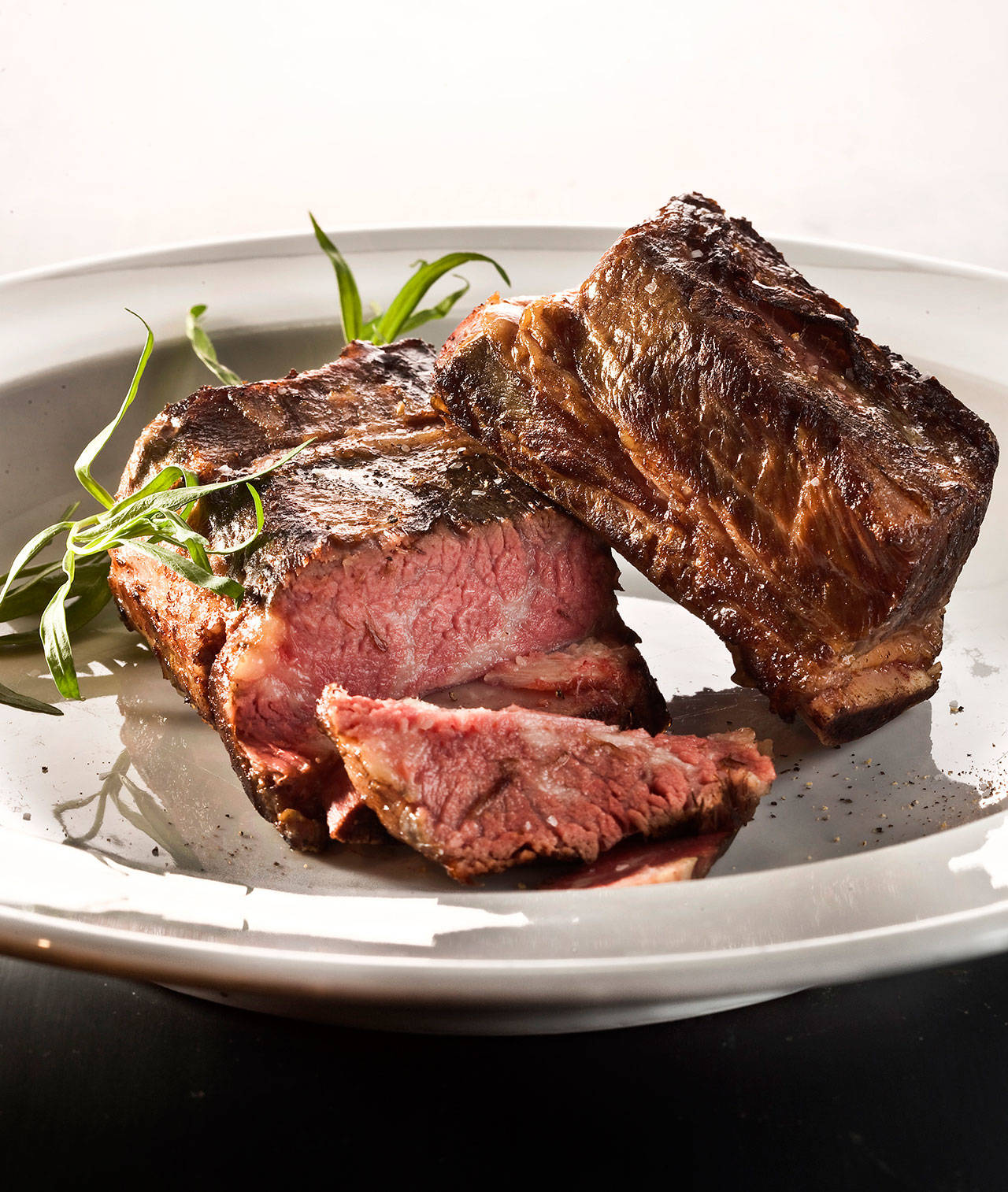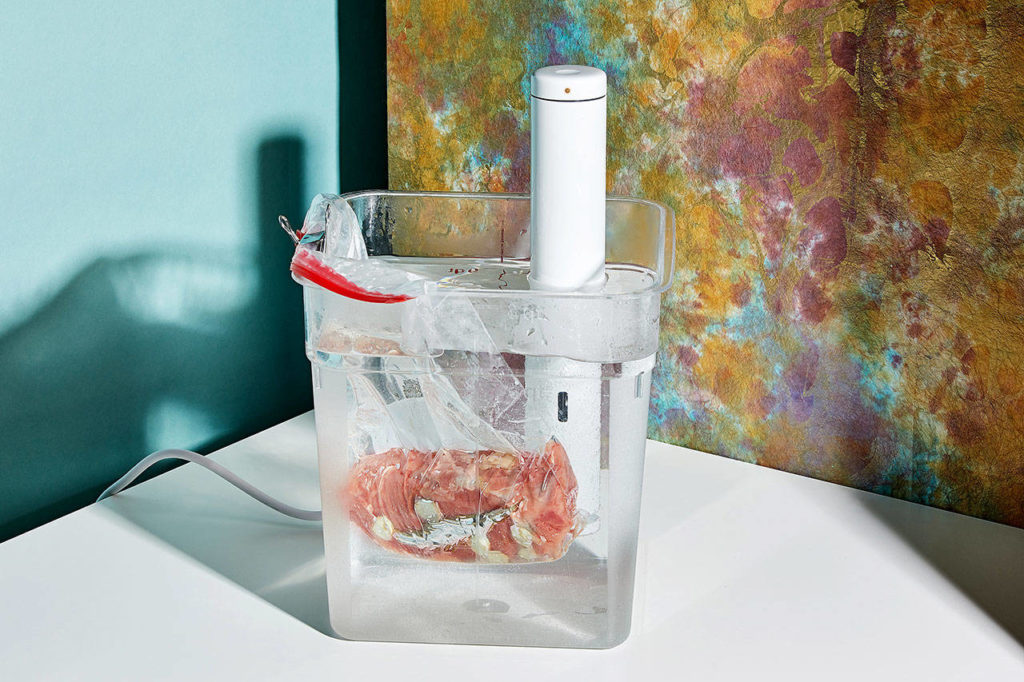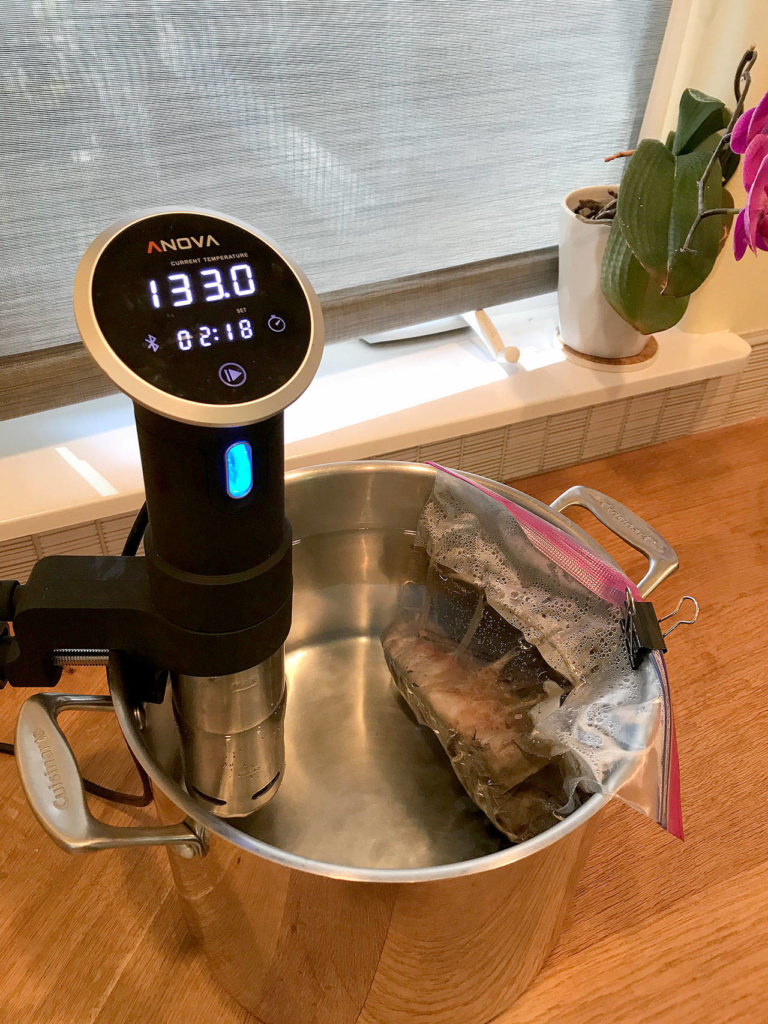It may be the ultimate cooking nightmare. You splurge on what restaurateurs call “luxury protein” — Alaskan king salmon, maybe, or a USDA prime porterhouse steak. It’s going to be a special dinner — but then disaster strikes.
You overcook your expensive cut of meat.
It’s happened to me more times than I like to admit — especially with salmon, which seems like it can go from just right to papery-dry and nearly inedible in an instant.
Recently, my grocery store ran a monthlong special on dry-aged beef — $15 a pound, down from $35. Such a deal — but could I properly cook the 2-pound, 2-inch-thick slabs of USDA prime goodness to the rare to-medium-rare doneness my family prefers?
The solution was sitting on a shelf in my pantry.
A couple of Christmases ago, I was gifted a sous vide machine. Sous vide, which means “under vacuum” in French, is a process of sealing food in a plastic bag and cooking it, often for many hours, to an exact temperature in a water bath. It used to be a technique available only to restaurants, but a new breed of home sous vide machines has changed that.
I tried the gadget a couple of times and was impressed with the results. But the long cook times didn’t mesh with our workdays and interminable commutes, so on the shelf it went.
Then came the COVID-19 pandemic. Working from home makes it possible to get the sous vide cooker going during my afternoon coffee break, then enjoy perfectly cooked steaks at dinner four hours later.
Expensive steaks are one thing, but sous vide cooking also works wonders with cheap cuts like round roast. Long cook times at precise temperatures turns them from tough to succulent. Imagine a $3.99-per-pound chunk of meat that’s as tender as a tenderloin.
Sous vide machines for home cooks generally run from $100 to $150. Anova Culinary and Breville Joule are the leading brands. Both connect over Bluetooth or Wi-Fi to a smartphone.
They’re dirt-simple to operate. Grab a large container — I use a 12-quart stockpot — and fill it with water. Set the cooker in the water, clamp it to the side of the pot, plug it in and set your desired temperature. For example, if you want your steak to turn out medium rare, you’d set the temperature to 129 degrees. Season it with salt and pepper before sliding it into a plastic bag — or vacuum-sealing it, if you have one of those devices. If you use a bag, stick to name brands like Glad and Zip-Loc, whose products are guaranteed to be food safe. You’ll need a gallon bag for roasts or multiple pieces of meat.
When the water has hit the target temperature, you vacuum-seal the plastic bag by closing it most of the way and slowly lowering it into the water until the bag is submerged, except for the open corner you’re holding. Close the corner, and you’re ready to cook. Don’t stress about getting a 100% perfect vacuum seal; if the bagged meat sinks, you’re good. You should fasten the bag’s top edge to the pot lip with a clothes pin or binder clip, so it doesn’t interfere with the sous vide device’s circulator.
Set your cook time — from 45 minutes for salmon fillets to 36 hours (or more) for beef brisket, and go do something else. With traditional cooking, there is a very short window of time during which your steak is perfectly cooked. With sous vide cooking, that window is stretched to hours. If you’re shooting for medium rare and set your cooker to 130 degrees, medium rare is what you’ll get, no matter how long the meat remains in the water bath.
That said, meat cooked under 130 degrees should not remain in the water for more than 2½ hours, for food safety reasons.
When your meat is done cooking, you’ll want to pat it dry with paper towels and sear it in a hot pan for about a minute per side. Then you’re ready to eat. Meat cooked the sous vide way doesn’t need to rest. Assuming you chose rare to medium-rare for your temperature, the meat will be pink all the way through, with thin bands of brown from the quick sear. In contrast, a traditionally cooked steam will probably be pink in the middle, with well-done meat closer to the edges.
The noted chef and food writer J. Kenji López-Alt authored an entertaining, informative guide to sous vide cooking that’s included in the Anova Culinary cooker’s smartphone app. He walks you through how to cook beef, pork, seafood and more. This method for cooking beef brisket, which is notoriously difficult to do right if you’re not a Texas barbecue master, results in brisket that’s as good as you can get in Austin, López-Alt writes. I can’t wait to try it.
Sous vide brisket
1 flat- or point-cut brisket, about 5 pounds
2 ounces coarsely ground peppercorns
2¼ ounces kosher salt
¼ teaspoon liquid smoke
¼ pink salt (optional)
Dill pickles, sliced yellow onion and white bread, for serving
Combine pepper, salt and pink salt if using in a small bowl. Rub ⅔ of the mixture over the surface of the brisket. Reserve the other ⅓. Slice the brisket in half crosswise so the pieces fit in large bags.
Set your cooker to 135 degrees for brisket with a tender, steak-like texture, or 155 degrees for a more traditionally textured brisket that falls apart when you pull at it.
Place each brisket half in a vacuum bag. Add 4 drops of liquid smoke to each bag. Let rest for 2 to 3 hours in the refrigerator.
Add brisket to water bath and cover the put with a lid or aluminum foil. Cook for 24 to 36 hours at 155 degrees or 36 to 72 hours at 135 degrees.
Allow cooked brisket to cool to room temperature before proceeding to the finishing steps.
Adjust oven rack to lower-middle position and preheat oven to 300 degrees. Remove brisket from sous vide bags and carefully blot dry with paper towels. The liquid in the bags can be added to barbecue sauce and simmered down to provide extra flavor.
Rub served salt and pepper mixture on brisket. Place brisket on a wire rack set on a rimmed baking sheet and place in oven. Roast until a deep, dark bark has formed, about two hours.
— Recipe from J. Kenji López-Alt / Anova Culinary
Talk to us
> Give us your news tips.
> Send us a letter to the editor.
> More Herald contact information.



























